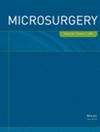Artery Grafting for Arterial Anastomoses in Head and Neck Free Tissue Transfer Reconstruction
Abstract
Background
Vessel grafting is an important technique in head and neck free tissue transfer (FTT) reconstruction when a tension-free anastomosis is not otherwise feasible. To our knowledge, there are limited data regarding interposition artery grafts for arterial anastomoses in head and neck reconstruction. Here, we present a multi-institutional cohort of arterial interposition grafts for FTT reconstruction for head and neck defects.
Methods
A retrospective review was conducted at four tertiary care institutions for patients who underwent FTT reconstruction for head and neck defects which utilized an interposition artery graft for the arterial anastomosis. Charts were reviewed for type and length of artery grafts harvested, surgical indication, indication for artery graft, types of flaps harvested, and various preoperative characteristics (including history of radiation or previous FTT reconstruction surgery). Postoperative complications within postoperative day 30 were measured and reported.
Results
Nine patients met inclusion criteria. The lateral circumflex femoral artery (either transverse or descending branches) (n = 3) and facial artery (n = 3) were the most commonly harvested arteries. The scalp (n = 5) was the most common primary defect site. Seven grafts were harvested initially and in a planned fashion, while two were harvested as salvage techniques (either for flap salvage or vein graft failure). In planned grafts, arteries were the preferred interposition grafting method due to either size match preferences (n = 4) or similarities in wall thickness (n = 3) between graft and recipient artery. There were no reported cases of unplanned readmission, postoperative hematoma, fistula formation, wound infection, or donor site morbidities. Two patients required unplanned return to the operating room for flap compromise, both of which ultimately resulted in flap failure secondary to clot formation at both arterial and venous anastomoses.
Conclusions
When arterial pedicle length is insufficient, interposition artery grafting is both a feasible and viable technique to achieve tension-free arterial anastomoses for select cases of highly complex head and neck free tissue reconstruction.

 求助内容:
求助内容: 应助结果提醒方式:
应助结果提醒方式:


